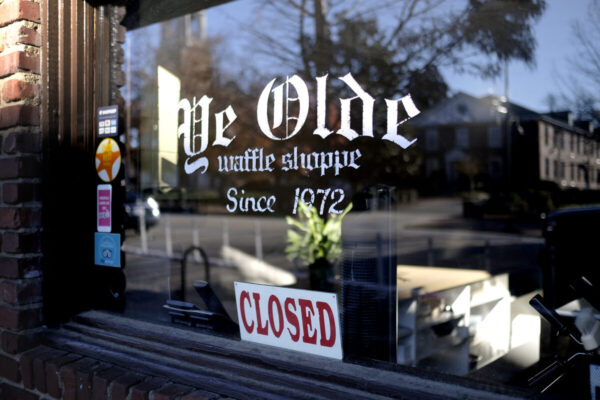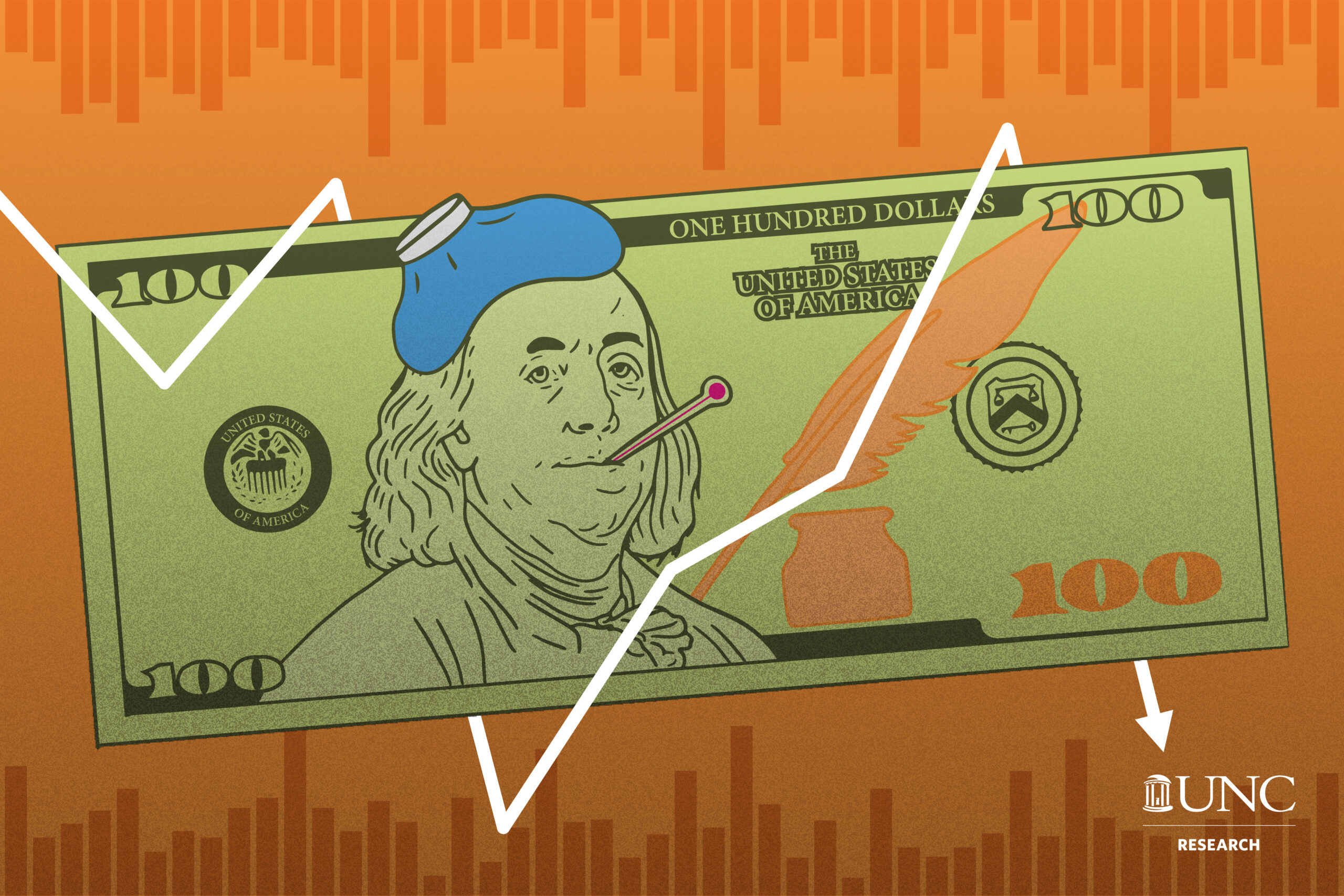Just four weeks after the World Health Organization declared the spread of COVID-19 a pandemic, Melissa Peng, the co-owner of Ye Olde Waffle Shoppe in Chapel Hill, created a GoFundMe campaign to raise money for her employees. She was only able to pay them for 10 days’ worth of work.
“[We] applied for small business loans and grants, but we heard today that all of the funding has been exhausted,” Peng wrote on the GoFundMe page, dated April 16, 2020. “None of the small businesses we know, including us, saw a dime of it.”
In a December 2020 interview with Carolina Insider, Peng and her mother and co-owner Linda Chris explained that they felt early on that this wasn’t going to be over anytime soon. Their gut instinct was driven by their family’s history with the 1918 Spanish flu, which took the lives of three of their ancestors.
On December 1, Peng and Chris announced on the Ye Olde Waffle Shoppe website that the 49-year-old Chapel Hill favorite would be closing its doors forever, heartbroken that they never got to have a “last breakfast” with their customers.

On December 1, Ye Olde Waffle Shoppe announced its closing online, thanking customers for decades of memories. (photo by Grant Halverson)
Ye Olde Waffle Shoppe is just one of many local venues that have closed since the pandemic began. Lula’s, Ms. Mong’s, and Elmo’s Diner also shut down permanently. In August 2020, Richard Morgan, owner of the iconic 51-year-old Morgan Imports in Durham, saw the pandemic as an impetus to close shop and retire. In January, the Raleigh-based heavy metal music venue the Maywood, and Coglin’s, a 1980s and ’90s-themed night club and bar, also closed. Just last month, Jellybeans Super Skate Center — a staple of the Cary community for the last 25 years — has followed suit.
Communities are changing nationwide. More than 10 million people are unemployed, food insecurity is rampant, and researchers predict that the pandemic will cause twice as much homelessness as the Great Recession.
These unprecedented changes have kept the American public, and the world, on the edge of their seats, unsure of when or how we’ll recover as a society. Will jobs come back? Will the economy recover? And what do we do in the meantime?
UNC economists and financial analysts are trying to find answers.
Support for the unemployed
Since 1960, there have been nine recessions in the United States, the most recent being the Great Recession of 2007 to 2009 when the housing bubble burst. When a recession occurs, the government usually employs an economic recovery package. For the one caused by the pandemic, that package is the Coronavirus Aid, Relief, and Economic Security (CARES) Act, which passed in March 2020.
These programs typically include an extension of unemployment insurance — and that’s what economist Stanislav Rabinovich is interested in. He studies the policies that dictate how much and when this money is distributed.
The CARES Act included a Federal Pandemic Unemployment Compensation program that gave unemployed workers an additional $600 each week from mid-March to July 31, 2020,more than doubling the amount typically provided. In a recent paper analyzing the effectiveness of the program, Rabinovich and Stockholm University’s Kurt Mitman found this course of action to be the most optimal distribution of money.
The key, Rabinovich says, is a generous dollar amount and a short extension period. He and Mitman also found that determining benefits should not be based on current unemployment rates, but the shock that triggered the recession to begin with.
“We want to provide some relief to unemployed workers, but at the same time we don’t want to disincentivize them from searching for a job,” he says.
This is called moral hazard — the idea that an increase in benefits will cause people to behave in ways that are counterproductive. And this is what often causes policy debates surrounding unemployment insurance.
“But this wasn’t a concern at the start of the pandemic,” Rabinovich says. “There were no jobs people could possibly search for. And we didn’t want them searching for jobs. We wanted them to stay home.”
A year in, that sentiment has changed slightly. On March 1, North Carolina Governor Roy Cooper issued an executive order requiring new claimants who apply for unemployment to prove that they’re searching for work. This is a standard requirement for those on unemployment, one that Cooper waived at the pandemic’s start.
While Rabinovich believes the unemployment insurance changes offered through the CARES Act have been successful in a lot of ways, they still had shortfalls. Many online unemployment systems crashed due to growing application rates, causing significant delays in benefit distribution. Additionally, many people thought they were ineligible for benefits or that the application process would be too difficult and so didn’t bother to apply at all. And then there were a handful of unemployment benefit scams, totaling approximately $63 billion, according to the U.S. Department of Labor.
“I think the timing of the legislation was fast, and our research suggests it was the right amount and duration — but all of that was assuming that the moment the CARES Act passed, people would be able to click a button and collect unemployment insurance. And that was not the case,” Rabinovich says.
How we move forward is vital. In December, the federal government reimplemented the Federal Pandemic Unemployment Compensation Program, which provided $300 per week until this past Sunday, March 14. President Biden’s new $1.9 trillion coronavirus relief bill has extended those benefits through September 6 and will provide most Americans who make less than $80,000 a year with a $1,400 stimulus check.
Rabinovich believes both the amount and expiration date for unemployment benefits within this package are appropriate. “I also think that the $1,400 stimulus check is an effective way to directly provide financial relief to households without tying it to unemployment and, therefore, without generating moral hazard,” he says.
Assuming that vaccine rollout continues as planned, the pandemic could be under control in a year’s time. This is due, in part, to the nature of the situation, Rabinovich points out. It is not a recession caused by, for example, a shift in manufacturing services or globalization. It was caused by an unexpected public health crisis that led to a drop in economic activity.
“And it’s on policymakers to make sure people can return to whatever it was they were doing before the pandemic,” Rabinovich says.
Implementing effective policies now for how, when, and how much unemployment gets distributed, he adds, is an important component of preventing long-term unemployment. Other policy measures that help workers include subsidies or loans that protect businesses from closing; lower taxes, which increase disposable income and demand; and incentives for education and training programs within workplaces.
COVID-19 cases and the stock market
In early 2020, the stock market fell 34 percent in 33 calendar days. This was three times faster than the last record plummet, which began on a day in 1987 now known as Black Monday.
That said, recovery from the springtime low has also been the fastest on record. By August 18, the market broke even and, at the end of 2020, the S&P 500 had risen 65 percent and the Nasdaq 44 percent since the March low struck.
While the stock market has recovered since the shutdown was first implemented, the number of daily COVID-19 cases still impacts next-day stock returns. UNC economist Anusha Chari and her colleagues found that when cases unexpectedly doubled, the Wilshire 5,000 — a benchmark for how the stock market performs as a whole — declined by 4 percent.
“That’s a pretty massive decline,” she says. “And the stock market reflects the impact on industries. Individual industries have been affected by the pandemic in different ways.”
Industries that have struggled include entertainment, construction, transportation, and hospitality. This makes sense as fewer people leave their homes or congregate in large groups. But health care has also suffered. This is, in part, because most elective surgeries — which drive business in hospitals — have been canceled.
Industries that have succeeded include agriculture, finance, insurance, administrative services, IT, and retail companies, such as grocery stores and large online retailers like Amazon and Wayfair. Transportation and warehousing companies that support retail, like UPS and Fed-Ex, have also done well.
As vaccine administration continues, stock market traders price the market in a forward-looking way. The more people who get vaccinated means the more likely it is they will return to work, book travel, go to movie theaters, and attend concerts.
“If you don’t get the virus under control, you’re not going to get the economy under control,” Chari says. “One uncertainty is the COVID-19 variants. If you talk to financial market participants, that’s one thing that gives them pause because it could impact the success of vaccine rollout.”
This is one reason why data surrounding the virus is so important: It drives the success of the economy. But the data isn’t always accurate, especially when it comes to infection rates. It’s nearly impossible to track asymptomatic carriers, and some people simply don’t get tested or go to the hospital when they do have symptoms.
In a recent paper, UNC Kenan Flagler Business School Professor Gregory Brown and UNC College of Arts & Sciences economics professor Eric Ghysels and PhD student Lu Yi estimated the number of undetected COVID-19 infections in the United States. In the earlier days of the pandemic, they believed that the actual number of cases was about three to four times the number of reported cases. That would mean the current 28.4 million cases is actually somewhere between 85 and 112 million. A research team at Columbia University believes undetected infections are as much as 10 times higher than those reported.
But they also found that case reporting has improved as testing has become more readily available, so the numbers you see today are probably much closer to the actual number of infections.
Knowing accurate case numbers is vital for predicting when the economy will recover.
“If you want to get an accurate calculation of when we’ll reach herd immunity, you have to know the total cases including the ones that were not detected,” Brown says. “We’re not going to have full economic recovery until people are comfortable doing pretty much everything they were comfortable doing prior to the pandemic.”
That said, the more cases we have, the less likely people are to leave their homes and the more likely the industries hit hard will continue to struggle.
Adapt and transform
The good news is that Rabinovich, Chari, and Brown all believe the economy will recover. Workers will return to their jobs, industries will thrive again, and new businesses will open their doors. But when that happens is largely dependent on case loads going down.
The bad news is the “scarring” the pandemic will leave behind. This is when businesses don’t reopen — like Ye Olde Waffle Shoppe. It’s unclear how much scarring will occur, Chari says.
Other businesses will adapt and transform.
“Before the pandemic, people were skittish about teleworking or working remotely, and there was this culture of you need to show up to the office,” Chari says. “And now people around the world are realizing a lot of work can actually be done from home.”
While this hurts some industries like commercial real estate, it boosts others like telehealth.
Chari points to China as an example of an economy that has bounced back and is leading global recovery. She believes the U.S. continues to struggle due to lack of solidarity on topics like masking and other public health measures.
“I think that if mask compliance, vaccination, and all these things are actually adopted, there’s potential for the economy to bounce back quickly,” she says. “And as soon as the second half of this year.”


